Turners
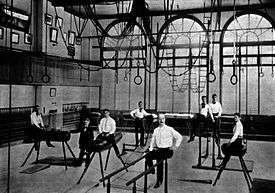
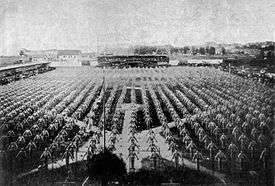
Turners (German: Turner) are members of German-American gymnastic clubs that also served as nationalist political groups that were politically active and often served in German military outfits as well as the Union Army in the United States during the American Civil War.
A German gymnastic movement was started by Turnvater ("father of gymnastics") Friedrich Ludwig Jahn in the early 19th century when Germany was occupied by Napoleon. The Turnvereine ("gymnastic unions") were not only athletic, but also political, reflecting their origin in similar "nationalistic gymnastic" organizations in Europe. The Turner movement in Germany was generally liberal in nature, and many Turners took part in the Revolution of 1848.[1]

After its defeat, the movement was suppressed and many Turners left Germany, some emigrating to the United States. Several of these Forty-Eighters went on to become Civil War soldiers, the great majority in the Union Army, and American politicians.[2] Besides serving as physical education, social, political and cultural organizations for German immigrants, Turners were also active in the American public education and the labor movements.[3][4][5] Eventually the German Turner movement became involved in the process leading to German unification.
History in the United States
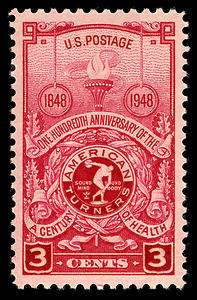
The Turnvereine made a contribution to the integration of German-Americans into their new home. The organizations continue to exist in areas of heavy German immigration, such as Iowa, Texas, Wisconsin, Indiana, Ohio, Minnesota, Missouri, Syracuse, NY, Kentucky, New York City, and Los Angeles.
Together with Carl Schurz, the American Turners helped support the election of Abraham Lincoln as president of the United States. They provided the bodyguard at his inauguration on March 4, 1861, and at his funeral in April 1865. In the Camp Jackson Affair, a large force of German volunteers helped prevent Confederate forces from seizing the government arsenal in St. Louis just prior to the beginning of the war.[6]
Like other German-American groups, the American Turners experienced discrimination during World War I. The German language was banned in schools and universities, and German language journals and newspapers were shut down, but the Turner societies continued to function.[3]
In 1948, the U.S. Post Office issued a 3-cent commemorative stamp marking the 100th anniversary of the movement in the United States.
Cultural assimilation and the two World Wars with Germany took a gradual toll on membership, with some halls closing and others becoming regular dance halls, bars or bowling alleys.[5] Fifty-four Turner societies still existed around the U.S. as of 2011. The current headquarters of the American Turners is in Louisville, Kentucky.[7]
The Turnverein Vorwaerts of Fort Wayne, Indiana, owned the Hugh McCulloch House from 1906 until 1966.[8]:2 It was listed on the National Register of Historic Places in 1980.[9]
Gallery
Vintage photos of the Milwaukee Turnverein
 1866
1866 1869
1869 1875
1875 1879
1879 1915
1915
Other Wisconsin Turners in 1915
 Kenosha
Kenosha Madison
Madison Madison Bears (seniors)
Madison Bears (seniors) New Holstein
New Holstein Sheboygan
Sheboygan
Jahn Monument in Berlin with memorial plaques from American Turnvereine
 Chicago, 1861
Chicago, 1861 Cincinnati, 1865
Cincinnati, 1865 Jahn Monument In Forest Park, Saint Louis MO
Jahn Monument In Forest Park, Saint Louis MO Philadelphia, 1861
Philadelphia, 1861 Washington, D.C., 1911
Washington, D.C., 1911 Davenport, Iowa Turngemeinde Monument
Davenport, Iowa Turngemeinde Monument
Turner Halls
- Turner Hall
Boonville, Missouri  Tuner Hall
Tuner Hall
Buffalo, Iowa Pilsen Turner Hall, Chicago, Illinois
Pilsen Turner Hall, Chicago, Illinois.jpg) Central Turner Hall (1848), Cincinnati, Ohio
Central Turner Hall (1848), Cincinnati, Ohio Germania Singing and Sport Society, Columbus, Ohio
Germania Singing and Sport Society, Columbus, Ohio Central Turner Hall (1888), Davenport, Iowa
Central Turner Hall (1888), Davenport, Iowa- East Turner Hall (1891), Davenport, Iowa
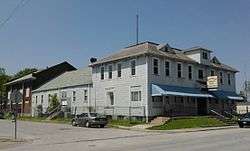 Northwest Turner Hall (1882), Davenport, Iowa
Northwest Turner Hall (1882), Davenport, Iowa Turner Hall
Turner Hall
Dubuque, Iowa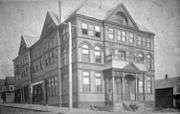 Turner Hall (1888), Duluth, Minnesota
Turner Hall (1888), Duluth, Minnesota
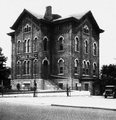 Elgin Turners
Elgin Turners
Elgin, Illinois- Turner Hall
Galena, Illinois 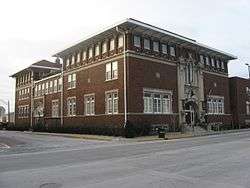 Independent Turnverein
Independent Turnverein
Indianapolis, Indiana South Side Turner Hall, Indianapolis, Indiana
South Side Turner Hall, Indianapolis, Indiana_by_Rudolf_Schwarz_(1899)_Control_IAS_IN000118.jpg) Detail, South Side Turner Hall, Indianapolis, Indiana
Detail, South Side Turner Hall, Indianapolis, Indiana- Germania Turnverein, Lancaster, Pennsylvania
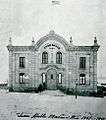 Turner Hall (1868), Madison, Wisconsin
Turner Hall (1868), Madison, Wisconsin
 Interior ca. 1910, Turner Hall, Milwaukee, Wisconsin
Interior ca. 1910, Turner Hall, Milwaukee, Wisconsin Turners Hall (1868)
Turners Hall (1868)
New Orleans, Louisiana Turner Hall
Turner Hall
New Ulm, Minnesota Turn-Verein, East 4th Street, New York, New York
Turn-Verein, East 4th Street, New York, New York_pg572_CENTRAL_TURN-VEREIN%2C_211_EAST_67TH_STREET.jpg) Central Turn-Verein, East 67th Street, New York, New York
Central Turn-Verein, East 67th Street, New York, New York
 Turnhalle
Turnhalle
Rock Island, Illinois
See also
| Wikimedia Commons has media related to Turner Halls. |
References
- ↑ Claire E. Nolte. "The German Turnverein". Encyclopedia of 1848 Revolutions. Retrieved January 9, 2011.
- ↑ Gruen, Mardee. "Milwaukee Turners, local Jews go back 141 years." Wisconsin Jewish Chronicle April 29, 1994; p. 6, col. 1
- 1 2 Annette R. Hofmann (August 3, 1998). "150 years of Turnerism in the United States". Indiana University-Purdue University Indianapolis Max Kade Center.
- ↑ John B. Jentz. "Turnvereins". Encyclopedia of Chicago. Missing or empty
|url=(help);|access-date=requires|url=(help) - 1 2 Mary Lou LeCompte. "TURNVEREIN MOVEMENT". Texas State Historical Association. Retrieved January 9, 2011.
- ↑ Scott Williams. "THE ROLE OF GERMAN IMMIGRANTS IN CIVIL WAR - MISSOURI". The Missouri Civil War Museum. Archived from the original on March 3, 2012. Retrieved January 10, 2011.
- ↑ "Welcome to American Turners". American Turners. Archived from the original on April 6, 2011. Retrieved January 9, 2011.
- ↑ "Indiana State Historic Architectural and Archaeological Research Database (SHAARD)" (Searchable database). Department of Natural Resources, Division of Historic Preservation and Archaeology. Retrieved July 1, 2015. Note: This includes Karen Anderson (November 1979). "National Register of Historic Places Inventory Nomination Form: Hugh McCulloch House" (PDF). Retrieved July 1, 2015. and Accompanying photographs.
- ↑ National Park Service (July 9, 2010). "National Register Information System". National Register of Historic Places. National Park Service.
Further reading
- Gertrud Pfister. "The Role of German Turners in American Physical Education," International Journal of the History of Sport 26 (no. 13, 2009) 1893-925
External links
- Website of the American Turners
- History of the American Turners By Henry Metzner
- Archives of the American Turners
- American Turner Topics newsletter
- Website of the Los Angeles Turners with history, photos, newsletters, and links to other Turners Organizations
- The American Turners, Wilmington Records and the Roxborough Turners Records, including by-laws, correspondence, minutes and photographs, are available for research use at the Historical Society of Pennsylvania.